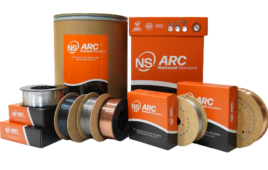Written by Miles Budimir, Senior Editor
WTWH Media

Welding is an assembly process whereby two or more parts are joined together, typically by means of heat although other methods (such as gas, laser, and ultrasonic) are also available. One of the main differences between welding and soldering or brazing is the temperature used.
Broadly speaking, there are three common techniques for joining metals together, thermally: welding, brazing, and soldering. Brazing, soldering, and welding are metal joining techniques that use heat as the main mechanism to bond two metals together. These processes also use some kind of flux to inhibit the oxidation of the metals.
However, this is where the similarities end.
The differences between welding and brazing relate to two key points: the temperatures used and how the temperatures impact the state of the metals.
The main characteristic of welding is that it uses high temperatures of about 1,000˚ C (1,832˚ F) or higher. One requirement of welding is that the base metals must be similar. So, for instance, steel is unable to weld to copper. It also differs from brazing and soldering in that it’s the only method of the three that melts the metals for joining with a filler metal. After cooling, the metals solidify to form a strong bond.
Welding also differs from brazing in that it melts the base metals that are then fused with the aid of a filler metal. The metals cool and solidify, forming a strong bond. The filler metal, sometimes called a “welding rod,” functions in a similar way to solder in brazing. Brazing temperatures are generally much lower than those used in welding.
This explains another difference. During brazing, the base metals are not melted — only the filler metal (or solder) melts and spreads out over the base metals, joining them together. The filler metal’s melting point must also be below that of the metals to be joined.
In contrast to welding, brazing can be used to join dissimilar metals together, such as copper, aluminum, and nickel. In fact, in both soldering and brazing, a metal alloy (or solder) is melted and flows over the two metals to be joined, connecting them together. The main difference between these soldering and brazing is the temperature.
The American Welding Society defines brazing as the process where the filler metal (i.e. solder) has a liquidus above 425˚ C (800˚ F). This means it becomes liquid or melts at temperatures above this point and begins to solidify below that temperature.

Soldering is often used in the electronics industry, typically on printed circuit boards. The solder’s core has a material known as flux, which connects and strengthens electrical bonds.
Soldering, on the other hand, involves filler metals with a liquidus below 450˚ C (842˚ F). In brazing, the most common heat source is a gas flame torch. Other methods include furnace brazing, dip brazing, electron beam, laser brazing, and others.
For soldering, the most common technique is to use a soldering iron. Other techniques, such as reflow or wave soldering, are used in high-volume manufacturing environments. Brazing and soldering use flux as a part of the process. It’s used to clean the metals to be joined, removing any oxidation and preventing any from forming.
Using the right flux for the job means ensuring that it’s chemically compatible with the metals and the solder. For instance, flux used in electrical soldering typically contains a rosin core while flux for brazing applications might use borax or other compounds.
Soldering is typically used in electronic applications, primarily to make an electrical connection. So, it’s not as mechanically strong as a brazing joint, which ensures a much stronger bond between the metals to be joined. Brazing also requires the parts to have a tighter fit than soldering to form a strong connection.
The most common brazing method is torch brazing, which uses a gas flame. Other common techniques include furnace brazing, which is conducive to industrial-level mass production applications. As for strength, a properly welded joint will typically be stronger than a brazed joint. However, a proper brazed joint will still be stronger than the individual pieces joined together.





Tell Us What You Think!